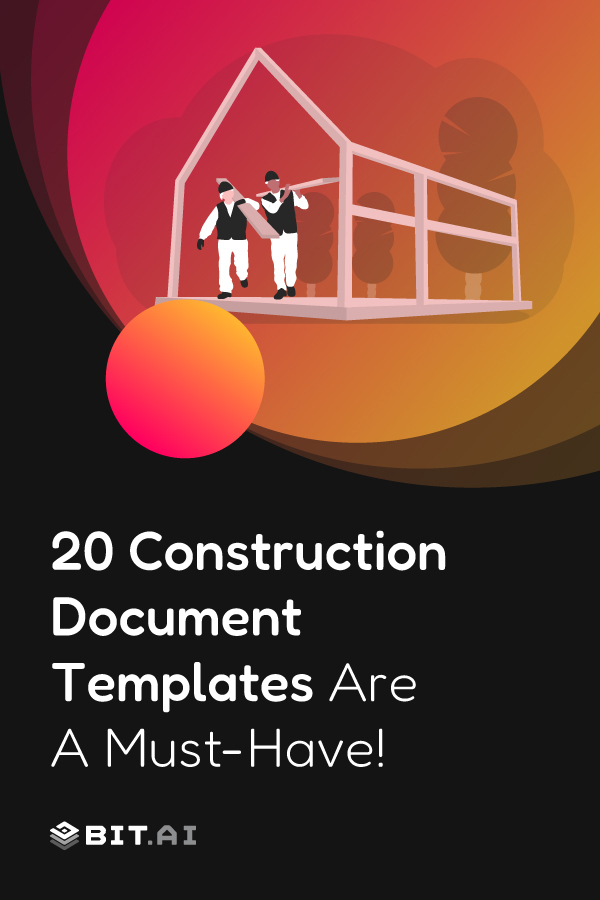Have you ever dreamt of building something incredible, but gotten stuck knee-deep in paperwork? Building your dream project, whether a backyard pizza oven or a multi-story office, requires a solid foundation – not just of bricks and mortar, but of documents. It’s about keeping your project on track, avoiding headaches, and ensuring everyone is on the same page.
But what if there was a toolbox filled with pre-made documents to keep your construction project on track? This list explores the top 20 construction document templates, designed to be your secret weapon against paperwork paralysis.
Construction document templates are essential for all stages of a project. They cover everything from bid solicitations and contracts to daily reports and final punch lists. Each template serves a specific purpose and helps in organizing information systematically, making it easier to track progress, manage resources, and ensure compliance with regulations. Without further ado, let’s dive into it!
What are Construction Documents?
Construction documents are a crucial set of papers and plans that provide detailed information about a construction project. They serve as the primary means for communicating the design and specifications from the architects and engineers to the contractors and builders who will execute the project. These documents typically include various types of drawings, specifications, schedules, and other relevant information necessary for the construction process.
Why are Construction Documents Important?
- Clear Communication: They ensure everyone involved has a shared understanding of the project requirements.
- Quality Control: They specify the standards for materials and workmanship, helping to ensure a high-quality finished product.
- Cost Management: By clearly defining the scope of work, they help to avoid cost overruns and change orders.
- Dispute Resolution: In case of disagreements, the construction documents provide a clear reference point for resolving disputes.
20 Top Construction Documents
1. Request for Proposal (RFP)
In construction projects, a request for proposal (RFP) is a document used by a project owner or manager to invite contractors and suppliers to bid on a project. It outlines the scope of work, project requirements, and expectations of the contractors who wish to be considered for the job.

| Section | Description |
| Project Overview | Brief description of the project, its objectives, and scope |
| Instructions to Bidders | How to prepare and submit their proposal, including deadlines and formats |
| Scope of Work | Detailed tasks or services required, including timelines and deliverables |
| Technical Specifications | Specific requirements for materials, methods, and performance standards |
| Contract Terms | Legal terms and conditions, including payment schedules and warranties |
| Evaluation Criteria | How proposals will be judged and what factors are important (like cost or quality) |
| Bid Form | Template for bidders to fill out their proposed costs and other details |
| Contact Information | Who to reach out to for questions and clarifications |
Each of these parts helps make sure that everyone knows what’s needed and how to make a good offer.
2. Scope of Work
The scope of work (SoW) is a crucial part of any construction project. It’s essentially a detailed description of all the work that needs to be done. Think of it as a roadmap that tells everyone involved—contractors, architects, and clients—exactly what’s expected and what will be delivered.
Here’s a table outlining the key components typically found in a Scope of Work:
| Component | Description |
| Project Overview | Brief summary of the project including its purpose and objectives. |
| Deliverables | List of specific items or outcomes that the project will produce. |
| Tasks and Activities | Detailed breakdown of the work to be performed, often in chronological order. |
| Schedule | Timeline for project milestones, including start and end dates. |
| Resource Requirements | Materials, equipment, and personnel needed to complete the project. |
| Budget | Estimated costs and budget allocation for the project. |
| Quality Standards | Criteria for assessing the quality of work and materials. |
| Risk Management | Identification of potential risks and strategies for mitigation. |
| Communication Plan | Guidelines for how information will be shared among team members and stakeholders. |
3. Construction Proposal or Construction Bid
A construction proposal or construction bid is a formal document submitted by a contractor to a potential client. It outlines the details of a construction project, including the scope of work, estimated costs, materials needed, and the timeline for completion. Essentially, it’s like a business plan for the construction job.

Here’s a table outlining the key components typically found in a Construction Proposal:
| Section | Description |
| 1. Introduction | Brief overview of the contractor, their qualifications, and the purpose of the proposal. |
| 2. Project Overview | Detailed description of the project, including its scope, objectives, and any specific requirements. |
| 3. Scope of Work | Clear outline of all tasks and activities that will be performed as part of the construction project. |
| 4. Schedule | Timeline for different phases of the project, including start date, milestones, and completion date. |
| 5. Cost Breakdown | Itemized list of costs, including labor, materials, equipment, permits, and any other expenses. |
| 6. Payment Terms | Details about how and when payments are expected, including milestones or percentage completion payments. |
| 7. Terms and Conditions | Legalities such as warranties, insurance requirements, dispute resolution procedures, and safety protocols. |
| 8. Contractor’s Credentials | Information about the contractor’s licenses, certifications, insurance coverage, and references. |
| 9. Appendices | Additional documents that support the proposal, such as blueprints, technical specifications, or past project examples. |
4. Construction Estimate
A construction estimate is essential for planning and budgeting before starting any building work. It helps contractors, architects, and clients understand how much money the project will likely require. Think of it as a roadmap that outlines the financial aspects of the construction project.
A good construction estimate should include several key elements to provide a clear picture of the project’s costs. Here’s a table outlining what it typically includes:
| Component | Description |
| Project Description | Brief overview of the project, including its scope and purpose. |
| Materials | List of all materials needed for the project, along with their quantities. |
| Labor | Estimate of the number of workers needed and their hourly rates or wages. |
| Equipment | Cost of any special machinery or tools required for the construction work. |
| Subcontractor Costs | If any parts of the project will be outsourced to subcontractors, their costs. |
| Overhead | General expenses like utilities, insurance, and administrative costs. |
| Profit Margin | Percentage of the total cost added to cover the contractor’s profit. |
| Contingency Fund | Reserve set aside for unexpected expenses or changes in the project. |
| Taxes | Estimated taxes applicable to the project. |
| Permits and Fees | Costs associated with building permits, inspections, and other regulatory fees. |
| Transportation | Expenses related to transporting materials and equipment to the site. |
| Miscellaneous Costs | Any other relevant costs not covered by the above categories. |
| Total Estimated Cost | Sum of all the above components, providing the overall estimated project cost. |
| Payment Schedule | Breakdown of when and how payments will be made during the project timeline. |
| Terms and Conditions | Important details regarding payment terms, project timelines, and responsibilities. |
5. Construction Budget
A construction budget is a detailed financial plan that outlines all the costs required to complete a construction project. It’s like a roadmap for spending money during the building process. This document is crucial because it helps everyone involved in the project understand how much money is needed and where it will go.

| Item | Description |
| 1. Project Overview | Brief description of the project including goals and scope. |
| 2. Cost Estimates | Detailed breakdown of estimated costs for materials, labor, equipment, permits, and other expenses. |
| 3. Contingency Funds | Additional money set aside (usually a percentage of the total budget) for unexpected expenses. |
| 4. Schedule of Payments | Timeline for when payments are due, based on project milestones or completion of specific tasks. |
| 5. Financing Plan | Details on how the project will be financed, including loans, grants, or equity investments. |
| 6. Bid Documents | Costs from bids submitted by contractors or suppliers, if applicable. |
| 7. Overhead Costs | Indirect costs such as insurance, utilities, and administrative expenses related to the project. |
| 8. Professional Fees | Fees paid to architects, engineers, and consultants involved in the project. |
| 9. Permit Fees | Costs associated with obtaining necessary permits and licenses. |
| 10. Taxes | Estimated taxes that may apply to the project. |
| 11. Inflation Factors | Adjustments for potential increases in costs due to inflation over the project timeline. |
| 12. Design Changes | Contingency for changes or revisions to the original project design. |
| 13. Inspection Fees | Costs for inspections and quality control throughout the construction process. |
| 14. Land Costs | Expenses related to purchasing or leasing the construction site. |
| 15. Utilities | Costs for connecting utilities such as water, electricity, and sewage to the site. |
| 16. Safety Costs | Budget allocation for safety measures and equipment on the construction site. |
| 17. Environmental Costs | Expenses for environmental assessments or mitigation measures. |
| 18. Maintenance Costs | Funds set aside for ongoing maintenance or repairs after the construction is complete. |
| 19. Profit Margin | Allocation for the contractor’s profit margin, if applicable. |
| 20. Final Total | Sum of all estimated costs, including contingencies and fees, to give the overall project budget. |
6. Construction Plan
A construction plan is a crucial document in the building process. It outlines every step and detail of the construction project. This includes things like what materials will be used, how things will be built, and when each part of the project will happen. It’s created by architects, engineers, or construction managers to guide the entire team.
Here’s a table showing what a construction plan typically includes:
| Section | Description |
| Project Overview | Brief summary of the project, including goals and objectives |
| Site Information | Location details, site boundaries, access points, and existing conditions |
| Architectural Plans | Detailed drawings of the building’s design, floor plans, elevations, and sections |
| Structural Plans | Plans detailing the structural elements of the building (e.g., foundations, beams) |
| Mechanical Plans | Diagrams for HVAC (Heating, Ventilation, and Air Conditioning) systems and plumbing |
| Electrical Plans | Layouts for electrical systems, outlets, switches, and lighting |
| Construction Schedule | Timeline of tasks and deadlines for each phase of construction |
| Materials List | Comprehensive list of materials needed, including specifications and quantities |
| Budget | Estimated and actual costs for the project, broken down by phase |
| Quality Assurance | Procedures to ensure construction meets quality standards |
| Safety Plan | Measures to protect workers and prevent accidents during construction |
| Environmental Impact | Assessment of how construction will affect the environment |
| Permits and Approvals | Documentation required to legally start and complete the project |
| Risk Management | Identification and mitigation of potential risks and how to address them |
| Communication Plan | How information will be shared among the project team and stakeholders |
| Closeout Procedures | Steps for final inspections, testing, and handing over the completed project |
| Appendices | Additional information like technical drawings, specifications, or contracts |
Read More: Construction Schedule: What is it & How to Make it?
7. Construction Schedule
A construction schedule is a detailed plan that outlines all the activities and tasks that need to be completed during a construction project. It serves as a roadmap for the entire project, helping to ensure that everything is completed on time and within budget. The schedule typically includes start and end dates for each task, as well as milestones and deadlines that need to be met. It is an essential document for project managers, contractors, and stakeholders to keep the project on track and manage resources effectively.
| Task | Description | Start Date | End Date | Duration (Days) | Predecessor Task(s) | Notes |
| Site Preparation | – Demolition (if applicable) – Clearing and grading – Setting up utilities | |||||
| Foundation | – Excavation – Footing and foundation pouring – Backfilling and compaction | Task: Site Preparation | ||||
| Framing | – Floor framing – Wall framing – Roof framing | Task: Foundation | ||||
| Plumbing | – Rough plumbing installation – Drain line installation – Vent stack installation | Task: Foundation | ||||
| Electrical | – Rough electrical wiring – Panel box installation – Conduit installation | Task: Foundation | ||||
| HVAC | – Ductwork installation – HVAC unit installation | Task: Framing | ||||
| Insulation | – Wall insulation – Ceiling insulation | Task: Framing | ||||
| Drywall | – Hanging drywall – Taping and mudding | Task: Insulation | ||||
| Roofing | – Shingle installation – Flashing installation | Task: Framing | ||||
| Windows & Doors | – Window and door installation – Trimming | Task: Drywall (for interior doors) | ||||
| Exterior Finishes | – Siding installation – Painting – Gutters and downspouts | Task: Roofing | ||||
| Interior Finishes | – Flooring installation – Painting – Trim installation | Task: Drywall | ||||
| Cabinets & Countertops | – Cabinet installation – Countertop installation | Task: Interior Finishes | ||||
| Fixtures & Appliances | – Installing toilets, sinks, faucets – Appliance installation | Task: Interior Finishes | ||||
| Final Inspection & Cleanup | – Final inspections by code officials – Final cleaning | Task: Fixtures & Appliances |
8. Construction Specifications
Construction specifications, often referred to as “specs,” are detailed written instructions used in the construction industry. They describe the materials, processes, and quality standards required for a construction project. These documents help ensure that everyone involved in the project, from architects and engineers to contractors and builders, is on the same page and understands exactly what needs to be done. They are essential for achieving consistency, quality, and compliance with regulations.

| Section | Details |
| Title Page | Project Name: Location: Owner: Architect/Engineer: Date of Issue: |
| Table of Contents | List all sections and divisions with page numbers. |
| General Conditions | Responsibilities of parties: Contract terms: Insurance and bonds: |
| Supplementary Conditions | Modifications to general conditions: Project-specific requirements: |
| Division 01 | |
| Division 02 | |
| Division 03 |
9. Bill of Quantities
A Bill of Quantities (BOQ) is a crucial document used in the construction industry. It is a detailed list that outlines all the materials, parts, and labor required for a construction project. The BOQ helps in estimating the overall cost and ensures that all aspects of the project are considered. By itemizing each element of the construction process, it aids contractors, clients, and project managers in understanding the scope and financial requirements of the project.
| Item No. | Description | Unit | Quantity | Unit Rate ($) | Total Cost ($) |
| 1 | Excavation work | Cubic Meter | 50 | 10.00 | 500.00 |
| 2 | Concrete foundation | Cubic Meter | 30 | 100.00 | 3,000.00 |
| 3 | Brickwork | Square Meter | 200 | 20.00 | 4,000.00 |
| 4 | Roofing | Square Meter | 150 | 25.00 | 3,750.00 |
| 5 | Windows installation | Unit | 20 | 50.00 | 1,000.00 |
| 6 | Electrical wiring | Meter | 500 | 2.00 | 1,000.00 |
| 7 | Plumbing | Meter | 200 | 3.00 | 600.00 |
| 8 | Painting and finishing | Square Meter | 300 | 5.00 | 1,500.00 |
| 9 | Flooring | Square Meter | 250 | 10.00 | 2,500.00 |
| 10 | Landscaping | Square Meter | 100 | 15.00 | 1,500.00 |
| Total Cost | 19,350.00 |
10. Material Takeoff
A material takeoff (MTO) is a crucial document in the construction industry that details the quantities and types of materials required to complete a project. It serves as a comprehensive list, ensuring that builders and contractors have everything they need to successfully complete a construction job. Think of it as a shopping list for all the materials necessary for a project, but with precise quantities and specifications.
| Item No. | Description | Quantity | Unit of Measure | Specifications | Notes |
| 1 | Concrete | 50 | Cubic Yards | 3000 psi strength | Delivery on-site |
| 2 | Steel Rebars | 200 | Pieces | Grade 60, 20ft | Bend as per plan |
| 3 | Plywood Sheets | 100 | Sheets | 4×8 ft, 3/4 inch | Exterior grade |
| 4 | Bricks | 5000 | Pieces | Standard size | Red, smooth finish |
| 5 | Insulation Foam | 150 | Rolls | R-30, 15 inches | Fire-resistant |
| 6 | PVC Pipes | 300 | Linear Feet | 4-inch diameter | Schedule 40 |
| 7 | Paint | 20 | Gallons | White, matte | For interior walls |
| 8 | Windows | 25 | Units | Double-glazed | Custom sizes |
| 9 | Doors | 10 | Units | Solid wood | Pre-hung |
| 10 | Roofing Shingles | 60 | Bundles | Asphalt, gray | 30-year warranty |

11. Schedule of Values
A Schedule of Values (SOV) is a key document in construction that acts like a financial roadmap for your project. It breaks down the total project cost and assigns values to different stages or components of the work.
Here’s how it works:
- Think of it as a pie chart: The total project cost is like the whole pie.
- The SOV slices the pie: Each slice represents a specific portion of the work, like foundation, framing, electrical wiring, etc.
- Each slice has a value: This value reflects the agreed-upon cost for completing that specific part of the project.
| Item No. | Description of Work | Scheduled Value ($) | % of Work Completed | Value of Work Completed ($) | Previous Billings ($) | Current Payment Due ($) | Remaining Balance ($) |
| 1 | Site Preparation | 10,000 | 50% | 5,000 | 0 | 5,000 | 5,000 |
| 2 | Foundation | 20,000 | 25% | 5,000 | 0 | 5,000 | 15,000 |
| 3 | Framing | 30,000 | 0% | 0 | 0 | 0 | 30,000 |
| 4 | Electrical Systems | 15,000 | 10% | 1,500 | 0 | 1,500 | 13,500 |
| 5 | Plumbing | 10,000 | 20% | 2,000 | 0 | 2,000 | 8,000 |
| 6 | HVAC Systems | 12,000 | 0% | 0 | 0 | 0 | 12,000 |
| 7 | Interior Finishes | 18,000 | 0% | 0 | 0 | 0 | 18,000 |
| 8 | Exterior Finishes | 25,000 | 0% | 0 | 0 | 0 | 25,000 |
| 9 | Landscaping | 5,000 | 0% | 0 | 0 | 0 | 5,000 |
| 10 | Final Inspections | 5,000 | 0% | 0 | 0 | 0 | 5,000 |
Explanation of Template Columns
- Item No.: The sequential number assigned to each task or element of work.
- Description of Work: A brief description of the work or task.
- Scheduled Value ($): The total cost allocated to that particular task.
- % of Work Completed: The percentage of the work that has been completed to date.
- Value of Work Completed ($): The dollar value of the work that has been completed based on the percentage completed.
- Previous Billings ($): The total amount billed in previous payment requests.
- Current Payment Due ($): The amount currently being requested for payment, calculated as the Value of Work Completed minus Previous Billings.
- Remaining Balance ($): The remaining amount to be paid for that task.
This table helps everyone involved in the project to see how much work has been done, how much it has cost so far, and how much more is needed to complete the project. It’s a key tool for keeping construction projects on track financially.
12. Construction Submittals
Construction submittals are critical documents used in the construction industry. They serve as a way for contractors to communicate details about the materials, products, and equipment they plan to use in a project. These documents ensure that everything meets the project’s specifications and the client’s requirements before any materials are ordered or any work begins.
Here is a simple template that can be used to create a construction submittal document:
| Section | Details |
| Project Information | |
| Project Name | [Name of the Project] |
| Project Number | [Project Identification Number] |
| Location | [Project Location] |
| Contractor Information | [Name and Contact Information of Contractor] |
| Submittal Information | |
| Submittal Number | [Unique Identifier for Submittal] |
| Submittal Date | [Date of Submittal] |
| Spec Section | [Relevant Specification Section] |
| Product Information | |
| Product Name | [Name of the Product] |
| Manufacturer | [Name of the Manufacturer] |
| Model Number | [Model Number of the Product] |
| Attachments | |
| Shop Drawings | [Attached/Not Attached] |
| Product Data | [Attached/Not Attached] |
| Samples | [Attached/Not Attached] |
| Material Safety Data Sheets (MSDS) | [Attached/Not Attached] |
| Review and Approval | |
| Reviewed By | [Name of Person Reviewing] |
| Approval Status | [Approved/Approved with Comments/Rejected] |
| Review Comments | [Comments from the Reviewer] |
| Review Date | [Date of Review] |
Read More: How to Create a Project Implementation Plan
13. Construction Daily Report
The construction daily report serves as a daily log that records everything happening on-site each day. This report is essential for maintaining clear communication among the project team, ensuring that everyone is aware of what has been completed, any problems that arose, and what needs to be addressed. It helps in monitoring the project’s progress, managing resources, and documenting any incidents or delays. The report is typically filled out by the site supervisor or project manager at the end of each workday.

| Section | Description |
| Project Information | |
| Project Name | Name of the construction project |
| Project Number | Unique identifier for the project |
| Date | The specific date of the report |
| Weather Conditions | |
| Weather | Description of the weather (e.g., sunny, rainy, cloudy) |
| Temperature | High and low temperatures of the day |
| Site Information | |
| Work Completed | Description of work completed during the day |
| Materials Delivered | List of materials delivered to the site |
| Equipment Used | List of equipment used on site |
| Labor | |
| Workers Present | Number and types of workers on site (e.g., electricians, plumbers) |
| Subcontractors | List of subcontractors present on site |
| Issues and Delays | |
| Problems Encountered | Description of any problems or delays and their impact on the project |
| Safety Incidents | Any safety incidents that occurred |
| Photos and Attachments | |
| Photos Attached | Indication of any photos taken and attached for documentation |
| Attachments | Any additional documents or reports attached |
| Signatures | |
| Prepared By | Name and signature of the person preparing the report |
| Approved By | Name and signature of the person approving the report |
14. Construction Timesheet
A construction timesheet is a document used in the construction industry to track the hours worked by employees on a particular project. It helps in monitoring labor costs, managing payroll, and ensuring that the project is on schedule. Timesheets are essential for project managers, payroll departments, and human resources to keep accurate records of employee work hours.
| Employee Information | Project Details | Date | Work Hours | Tasks Performed | Approval |
| Name: [Employee Name] | Project Name: [Project Name] | [Day] | Start Time: [HH AM/PM] | [Description of Task] | Supervisor: [Signature] |
| ID: [Employee ID] | Location: [Project Location] | [Day] | End Time: [HH AM/PM] | [Description of Task] | Date: [Date] |
| Job Title: [Job Title] | Project Code: [Project Code] | [Day] | Breaks: [Total Break Time] | [Description of Task] | |
| [Day] | Total Hours: [HH ] | [Description of Task] | |||
| [Day] | Overtime Hours: [HH ] | [Description of Task] | |||
| [Day] | Regular Hours: [HH ] | [Description of Task] | |||
| [Day] | Weekly Total: [HH ] | [Description of Task] |
15. Contractor Payment Schedule
In construction projects, a contractor payment schedule is a crucial document that outlines when and how much a contractor will be paid throughout the duration of a project. It ensures that contractors receive timely payments for their work and helps maintain the financial health of the project.
| Milestone Description | Percentage of Contract Amount | Amount Due ($) | Retention (%) |
| 1. Foundation Completed | 20% | $XX,XXX | 10% |
| 2. Rough Framing Done | 30% | $XX,XXX | 10% |
| 3. Electrical Installation | 20% | $XX,XXX | 10% |
| 4. Plumbing Installed | 15% | $XX,XXX | 10% |
| 5. Final Completion | 15% | $XX,XXX | Final Payment |
Read More: The Benefits of Contract Documents in Project Management!
16. Construction Change Order
A construction change order is a document used in the construction industry to officially record any changes made to the original plan or contract during a construction project. These changes can be due to various reasons such as design modifications, unforeseen issues, or client requests that alter the scope of work.
| Section | Description |
| Project Information | – Project name and address – Date of change order – Contractor’s name and contact information |
| Description of Change | – Detailed description of the change requested or required |
| Reason for Change | – Explanation of why the change is necessary or desired |
| Impact Assessment | – Time impact: How the change affects the project schedule – Cost impact: Additional costs involved |
| Approval Signatures | – Client’s signature and date – Contractor’s signature and date – Architect’s signature and date |
| Attachments | – Any supporting documents, revised drawings, or specifications related to the change |
17. Punch List
In construction projects, a punch list is a document that details the remaining work or defects to be corrected before final completion and handover. It serves as a checklist that ensures all aspects of the project meet the required standards and specifications. Typically, the punch list is created towards the end of the project, during the final stages of construction or renovation.

| Item Description | Location | Responsible Party | Priority | Deadline |
| Install missing tiles | Bathroom, 2nd floor | Contractor A | High | June 30, 2024 |
| Paint touch-ups | Living room | Painter B | Medium | June 25, 2024 |
| Fix electrical outlet | Kitchen | Electrician C | High | June 28, 2024 |
| Adjust cabinet doors | Master bedroom | Carpenter D | Low | July 5, 2024 |
| Repair cracked window | Office | Glazier E | High | June 30, 2024 |
18. Construction Lien Waiver
A construction lien waiver is a legal document that contractors, subcontractors, and suppliers use to protect property owners from potential claims of non-payment by other parties. When a construction project is completed, contractors typically submit invoices for payment. In return, they may be asked to sign a lien waiver.
| Details | Information |
| Project Name: | [Insert Project Name] |
| Project Address: | [Insert Project Address] |
| Owner: | [Insert Owner’s Name] |
| Contractor: | [Insert Contractor’s Name] |
| Subcontractor: | [Insert Subcontractor’s Name] |
| Date: | [Insert Date] |
| Invoice Number: | [Insert Invoice Number] |
| Amount Paid: | $[Insert Amount Paid] |
Waiver
The undersigned, [Subcontractor’s Name], acknowledges payment of $[Amount Paid] for labor/materials/services provided to the project at [Project Address]. This payment covers all work performed through [Date], and the undersigned waives the right to claim a lien for this amount.
Signatures
| Role | Name | Signature | Date |
| Owner | [Insert Name] | _____________________ | [Insert Date] |
| Contractor | [Insert Name] | _____________________ | [Insert Date] |
| Subcontractor | [Insert Name] | _____________________ | [Insert Date] |
19. Request for Information (RFI)
In construction projects, various details can be unclear or need further explanation. This is where an RFI comes in handy. It’s a written request from one party (like a contractor or subcontractor) to another (such as the architect or project manager) asking for more information about something related to the project.
Here’s a simplified template for an RFI that you can use as a reference:
RFI Template | |
| Project Name: | [Insert Project Name] |
| Date: | [Insert Date] |
| From: | [Your Company/Organization Name] |
| To: | [Recipient’s Name/Department] |
| Subject: | Request for Information (RFI) |
| Description of Issue: | [Describe the issue or question clearly and concisely.] |
| Background/Context: | [Provide any necessary background information.] |
| Request: | [Clearly state what information or action is needed.] |
| Attachments: | [List any relevant drawings, specifications, or documents.] |
| Contact Information: | [Provide contact details for follow-up or clarification.] |
20. Request for Quote (RFQ)
When a construction project needs to hire contractors, suppliers, or service providers, an RFQ is sent out to several companies. The RFQ typically includes details about the project, such as the scope of work, materials required, timelines, and any special conditions or specifications.
Here’s a simplified table outlining the sections typically included in an RFQ template:
| Section | Description |
| Project Overview | Brief description of the project, including its objectives and scope of work. |
| Timeline | Proposed start and end dates of the project, including any milestones. |
| Technical Specifications | Detailed requirements for materials, equipment, and methods to be used in the construction. |
| Scope of Work | Breakdown of tasks and responsibilities, specifying what the contractor is expected to deliver. |
| Bid Submission Details | Instructions on how and when to submit the bid, along with contact information for queries. |
| Evaluation Criteria | Criteria used to evaluate bids, such as cost, experience, qualifications, and proposed timeline. |
| Terms and Conditions | Legal and contractual terms that vendors must agree to if they submit a bid and are selected. |
| Appendices | Additional documents that may be relevant, such as site maps, blueprints, or regulatory approvals. |
Conclusion
To sum it up, using construction document templates makes managing construction projects easier. These templates are like ready-made forms that help teams handle important tasks smoothly, such as planning, budgeting, and safety. They save time, cut down mistakes, and keep everyone on the same page.
Overall, these templates are tools that help construction teams work better, stay organized, and deliver successful projects with less stress.
Good Luck!
Further Reads:
Top 15 Essential Client Project Documents!
9 Document Management Trends Every Business Should Know!
Business Description: Your Guide To Write One With Examples!
Sales Manager Job Description: How to Write it? (Steps & Example Included)


